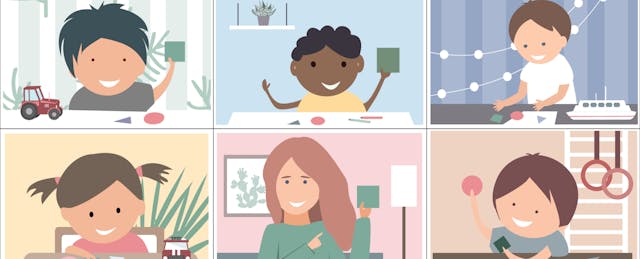Like millions of teachers around the country, Katie Gardner is still adjusting to an online workflow—and so are the families of her students. Gardner, who teaches kindergarten to English learners in Salisbury, N.C., says some students don’t have robust access to technology, so not all of them are able to participate.
Others have parents who are working essential jobs and no older siblings to help with schoolwork. Without such support, students may feel less comfortable—or inclined—to engage in an entirely new way of learning.
It’s a big reason why she believes in making sure students feel seen for what they can do.
“I think it’s important for those who complete tasks to share that work with the whole class,” says Gardner, who spoke at a recent EdSurge-ISTE webinar on supporting K-3 learners through the transition to remote learning, part of a larger series being held each Friday. “I show others: ‘Look what Miguel did. Look what he found at home. What can you do now?'” That, she adds, is helping many students feel appreciated during a difficult time.
The good news is that many teachers are finding a majority of students are participating in class at some level, says Gail Lovely, founder of the Early Learning Professional Learning Network at ISTE, which is the parent organization of EdSurge.
Engagement remains a tricky subject for many teachers, but some are finding creative ways to keep kids coming back, especially during whole-group discussions on video conferencing platforms such as Zoom. “Once students are participating at some level, they’re doing things like reading a chapter book and stopping it [at a] cliffhanger, and you have to come back the next day to hear the next piece,” says Lovely.
Teachers are also reaching out to families by phone to make sure they are supported, and asking if they need help, she adds, which can make a big difference.
Another piece of the puzzle? Peer-to-peer interactions—helping to recreate the social environment of school as best as possible. Teachers of older students are assigning group work and creating breakout chat rooms in Zoom. Younger children might use digital tools like Padlet to create drawings and leave comments with guesses as to what they represent, says Lovely. “That interaction can be via text, it can be audio, it can be an image. And that's all decided by the end user so the child and the child’s family can decide how they respond.”
Still, there will never be a complete substitute for human interaction. For young children, it’s tricky to recreate authentic peer-to-peer interactions, admits Rhian Evans Alvin, CEO of the National Association for the Education of Young Children. “I mean, how do you recreate a playdate at the park?”
Recreating those experiences may entail deeper family and community learning using video conferencing tools. “To the extent that parents can do what they would in a ‘Mommy and Me’ [play group] class, or grandma taking the children to the library reading session, you absolutely could do that using technology,” says Evans Alvin.
She acknowledged that equity issues in terms of internet access might make such connections impossible for some families. “We need to manage the expectations that we put on parents,” she says. “Giving simple messages around, ‘Don’t overdo this. Don’t be too hard on yourself.’”
That advice extends to teachers as well, says Gardner, the kindergarten teacher. “Start simple,” she suggests. “Even if it’s just Zooming together and singing a song, or doing a quick check-in morning meeting to ask ‘How are you feeling? What are you doing today?’”
One effective exercise is to ask a student to draw a flower digitally and then pass it along to another student to draw a bird to create a collaborative drawing, says Gardner. Her students are also compiling individual drawings into digital books.
“We can share together even though we’re physically not there in the classroom doing it together,” she says.
This is a very brief recap of the conversation. To hear the rest, listen to the episode in the player on this page. You can also find the EdSurge Podcast on Apple Podcasts, Overcast, Spotify, Stitcher, Google Play Music, or wherever you listen to podcasts.


